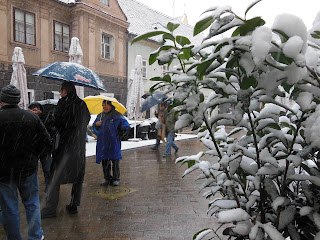Tuesday, March 12 – Zadar is a safe city in the summer as they recruit policeman from all over Europe to supplement their local force. Very smart move! They speak the languages of the tourists, they know their culture and they deport them immediately if there are issues! The government deports the eastern European gypsies also. As their economy is based on tourism, the safety of their visitors is very important.
 |
| Old City Wall and marina |
 |
| Croatian flag |
We toured another hotel by the sea (stone beach), the Falkensteiner Punta Skala, with three HUGE pools and incredible views. This is the only hotel in the country which is a member of the Leading Hotels of the World. Most beaches in Croatia are not sandy -- STONE. There are miles and miles of coastline but extremely few sand beaches. The water is supposed to be clearer with stone beaches, the fish are easier to see and there is no sand in your pants!
We drove to the village of Nin, to see one of the smallest Catholic churches in the world, built in the 8th century. It looked like a tree house placed on a mound, it was so small.
 |
| Nin church |
Zadar: Our walking tour with Paula was very informative. The maraschino liquor is the symbol of the city. Their Sea Organ (built in 2005) won national and international art prizes. The sea waves break against the “organ”, which was built under the promenade. Soft eerie sounds are emitted through pipe holes in the promenade/concrete , making a lovely sound. The oldest university is here – from 1396. Zadar was long under Venetian rule and the city was even given to Italy in 1`921 before being returned to Croatia as a part of Tito’s Yugoslavia in the late 1940s. There is a large fishing industry here and ferry hub to the local islands. Their main square, the Forum, had a “pillar of shame” for those who did not pay their taxes! Is this something to be considered locally?? The Cathedral of St. Anastasia is from the 12th century and near St. Donat’s church they hold musical evenings during the summer. The city was bombed over 70 times by the Allies during WWII and held under siege during the Homeland War.
We drove toward Drdnis, to the Etnoland village. Mr. Josko Lokas greeted us in traditional costume and walked and talked us through the ages and culture within a Croatian home.
"The ETNOLAND experience begins with your journey to the Dalmatian hinterland, to Pakovo Selo. There, after a formal and for us Dalmatians sacred welcome ceremony; you'll be welcomed into the village.
Listen to Dalmatians tell stories of their ancestors and history, see and learn about Dalmatian customs and tradition. See Dalmatian stone houses, traditional tools and utensils, learn how households were run, experience traditional Dalmatia and so much more.
ETNOLAND Dalmati offers visitors indigenous Dalmatian food and drinks, and delicacies such as those prepared under “peka” in the traditional way, “Drniški pršut” smoked ham, traditional red and white wine."
A house is set up with two beds (no matter how large the family), the loom/weaving area and the kitchen. The cellar below held the valuables of the family – the smokoed ham, the wine, the tools and money. We tasted the sweet local wines and had a nice dinner of pork and potatoes, salad and dessert. They showed a movie on processing the ham -- it takes up to 14 months to make their particular ham. It is just an hour from Split or Zadar and would be nice combination with Sibenik (a quaint UNESCO village).




We ended up in Trogir, also a UNESCO quaint village on the water, just a water taxi away from Split. The guide book claims: “A picture perfect prosperous fishing village with a lively Riva (bank) for strolling after dark, Trogir also has some charming architecture.” I agree 100%. We really enjoyed walking around at dusk through the narrow cobblestone streets, through the main square, watching the old shoemaker use a sewing machine from the 1900s (like my Grandmother’s) and to the market. The fort at the north end of the island has the local football/soccer field just behind it – a true sign of a modern medieval city.
Our Hotel Palace was a short walk away from the old town of Trogir. Remember these old towns do not have large hotels in their centers: cobblestones and wheeled suitcases make for interesting moments.
 |
| Trogir |
 |
| Gene at gate in Trogir |
 |
| Gene at Fortress in Trogir |
 |
| Homemade sausages and cheese in daily market |
We saw an interesting electronic "orange cone" concept on a busy one way street. This "cone" is electronic and you have a code to call (and pay!) to have the cone lowered so you can exit the area.
 |
| Electronic "orange cone" |













































